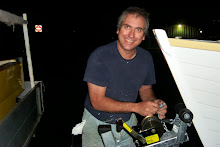Ross, this is precisely the problem I face in my own region sailing in the Great Lakes USA. The water never gets warm, really, and getting a dousing is not a lot of fun, especially as one ages and gets "thin blood." Your first picture illustrates perfectly the trouble my 15 ft sailboat gives me. And while she sails very well, I increasingly feel the need to replace her with a drier boat.
I figured the problem was that there was not enough flare in the top sides of my boat's fwd section. Does flare contribute to a fine entry? The relationship between the two is not clear to me and the picture of Phoenix III seems to challenge that supposition. Can one have a beamier boat than the Phoenix III, say 6 ft, on a 15-15.5 ft length and still attain a fine entry to the bow you mention in your blog?
Best, Dennis
Well, this is a very good selection of questions, and the answer to all is, "Yes and No".
Yes, flare can contribute to a fine entry angle at the waterline and below, but it is only one of the design elements involved. To get a combination of flare, adequate breadth (or beam, as it is commonly called), and fine entry angles, you usually need to have a construction method which allows for compound curves in the structure. I will describe an exception shortly, but compound curves normally eliminate sheet material (for us that means plywood) as a building material.
 |
| The forward sections of Phil Bolger's Harbinger design |
There are other options. Take as an example this lobster boat - also a Phil Bolger design, which I built using glued-lapstrake planking.
 |
| Planty of flare, but lots of planks |
 |
| Phil Bolger Hope showing her fine lines |
Once again, there is plenty of flare and a fine entry angle - all in a boat which is wide for her length. In this case I was only able to achieve the required shape by using a lot of narrow planks. In therory, if I had used an infinite number of planks, I could have achieved any shape I wanted, but the building process would by infinitely time-consuming and infinitely heavy - so a compromise had to be reached.
When I was designing Phoeinx III and Periwinkle, I was determined to use the minimum number of planks which was consistent with an nice hull shape. This allowed me to capitalise on the wide planks which could be cut from standard sheets of plywood, while at the same time reducing the marking, cutting, and gluing labour time for the builder. Once again a compromise. The individual planks were wide enough to need to be 'developable' shapes, but I still had more latitude with hull shape than would be the case with a sheet plywood boat.
 |
| The first Periwinkle awaiting her launching |
 |
| Periwinkle, showing that she is relatively long and narrow. |
To visualise this, consider taking a sheet of card, bending it into a section of a cylinder, and then trying to bend it in another plane - it just won't work. If you bend a section of sheet material, it must take up a shape which is a segment of a cone or a cylinder. Therefore, you will always find a place on the curved surface where you will be able to lay a straight edge, and have it contact the surface along its length.
Now, it is possible to draw, using geometry, a surface which is composed of a number of adjacent cones and cylinders, but it is very time-consuming, and the resulting hull shapes are limited. Many thousands of stringer/frame plywood boats have been built this way over the decades, but they are generally fairly blunt and full in their forward sections. The resulting design options are limited.
 |
| Here is a good example of a plywood boat with developable panels taking up the normal sort of shape common to this design method. A nice boat, but fairly blunt up forward. |
 |
| Bottom panels of Flint cut to shape..... |
 |
| ...unfolded..... |
 |
| ...and made into a boat.... |
 |
| ...which goes nicely with a beautiful, flared and fine entry - all from sheet plywood. |

Thanks for your insightful comments, Ross. I appreciate them very much. Happy Easter, Dennis
ReplyDeleteHi Ross,
ReplyDeleteHave really enjoyed the last couple of posts. I like thinking about the laps as spray rails, it added another dimension to what I thought of as simply a nod to tradition.
On the matter of fine entry + flare I would like to make an observation - is this discussion of fine entry and flare dependent on hull type? I am thinking of flat bottomed sharpie hulls in particular. These hulls often have nearly plum or vertical sides, but are designed to be sailed with a fair amount of heel, thus introducing a degree of flare. Also, the most successful sharpies have a fair amount of rocker in their flat bottoms, this means that more often than not they carry their stems at or above the waterline. I think that Bolger's Black Skimmer is an excellent example.
Are the needs for flare and fine entry different between say, displacement hulls versus planing hulls, or between boats that are designed to be sailed fairly flat versus those with a little heel?
cheers,
Graham
Nice blog posst
ReplyDelete